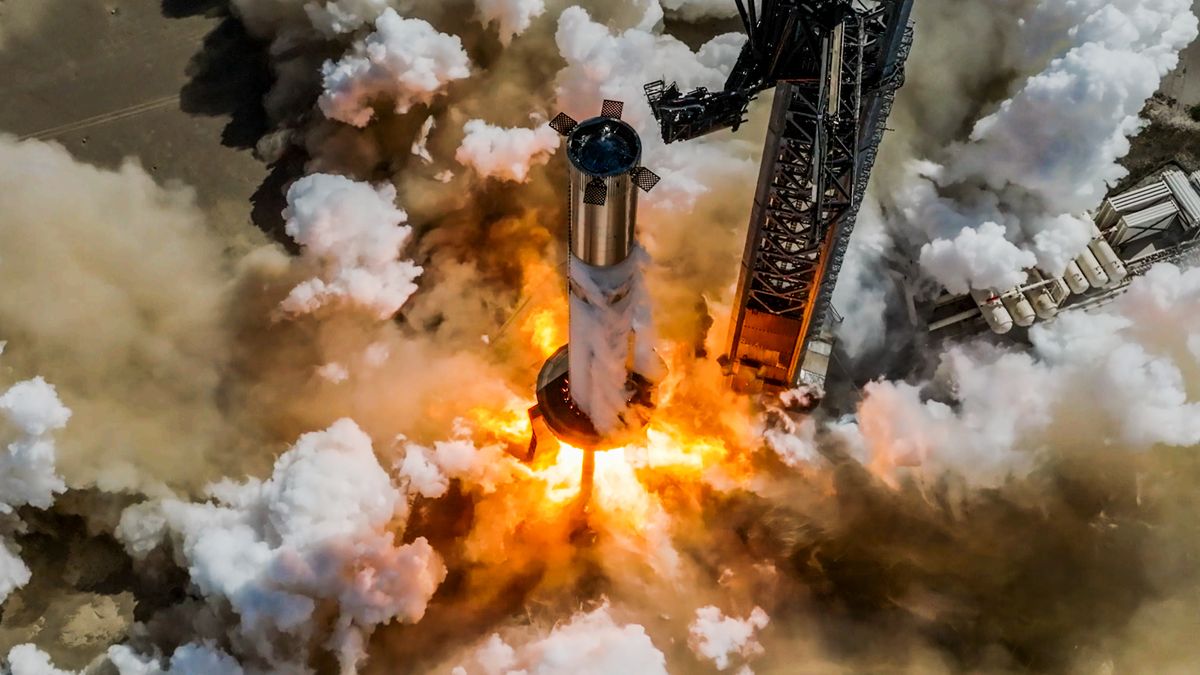SpaceX is on the cusp of launching its fourth Starship test flight, embarking on a mission to breach the thermal barriers that hindered previous attempts.
This colossal spacecraft, envisioned as the future chariot carrying astronauts to the Moon and Mars, will undergo a fiery trial by re-entry in June 2024. A successful test flight would mark a significant milestone in humanity’s quest to become a multiplanetary species.

On April 5, 2024, SpaceX will test the Super Heavy rocket that will launch the fourth Starship test flight during a static-fire test. (Photo courtesy of SpaceX via X)
A Colossus Awakens: Preparations Underway at Starbase
At Starbase in Boca Chica, Texas, an imposing sight greets the eye – the towering silhouette of Starship, comprised of both the Super Heavy booster and the upper stage, stands poised for its next test flight. Images shared by SpaceX and Elon Musk himself, likely via Twitter, showcase the ongoing preparations. The target launch window set for June 2024 signifies a more frequent testing cadence compared to the previous intervals of 7 and 4 months between launches, highlighting SpaceX’s commitment to accelerating Starship’s development.
From Ashes to Ambition: Pushing the Boundaries of Re-entry
This upcoming test flight carries a critical objective – to propel Starship beyond the peak heating zone encountered during its harrowing third mission. On March 14, 2024, Starship’s third test flight inched closer to achieving this goal, but ultimately succumbed to the scorching inferno of atmospheric re-entry. Despite reaching a new altitude record, the innovative 18,000 hexagonal heat shield system proved inadequate in the face of the extreme temperatures.
The earlier test flights, while ending in explosions shortly after takeoff, were far from failures. They provided invaluable data that fueled Starship’s development. These early tests were crucial stepping stones, paving the way for the more ambitious goals of the upcoming flight. SpaceX meticulously analyzed the telemetry and wreckage from these pathfinder missions, employing the learnings to refine Starship’s design and bolster its resilience.
Building a Multiplanetary Future: Every Test Flight a Stepping Stone
The Starship test program represents a series of stepping stones towards a singular, audacious vision: the creation of a reliable spacecraft capable of facilitating interplanetary travel. By achieving this feat, humanity would take a giant leap towards becoming a multiplanetary species, no longer confined to the cradle of Earth.
SpaceX’s immediate aspirations focus on enabling manned missions to Mars, the rusty red neighbor that has captivated humanity’s imagination for centuries. Starship could also play a vital role in transporting personnel and supplies to a potential lunar base, establishing a foothold on Earth’s natural satellite. Starship boasts an impressive payload capacity – 100 tons for interplanetary voyages and a staggering 150 tons for missions within Low Earth Orbit. This immense carrying capacity makes Starship a versatile workhorse, capable of supporting a myriad of future space endeavors, from constructing space stations in orbit to facilitating the transport of large payloads to the Moon or Mars.
The upcoming June launch represents a pivotal moment for Starship’s development. As SpaceX pushes the boundaries of heat resistance and refines its design through the crucible of real-world testing, the dream of venturing beyond Earth becomes increasingly tangible. The success of this test flight would be a testament to human ingenuity and a harbinger of a future where humanity’s footprint extends beyond our home planet, leaving its mark on the celestial canvas. The coming months will be filled with anticipation as SpaceX prepares to send Starship hurtling skyward, its fiery re-entry serving as a baptism by fire for this ambitious spacecraft. The data gleaned from this critical test will be instrumental in determining the trajectory of Starship’s development and its potential role in ushering in a new era of space exploration.



















